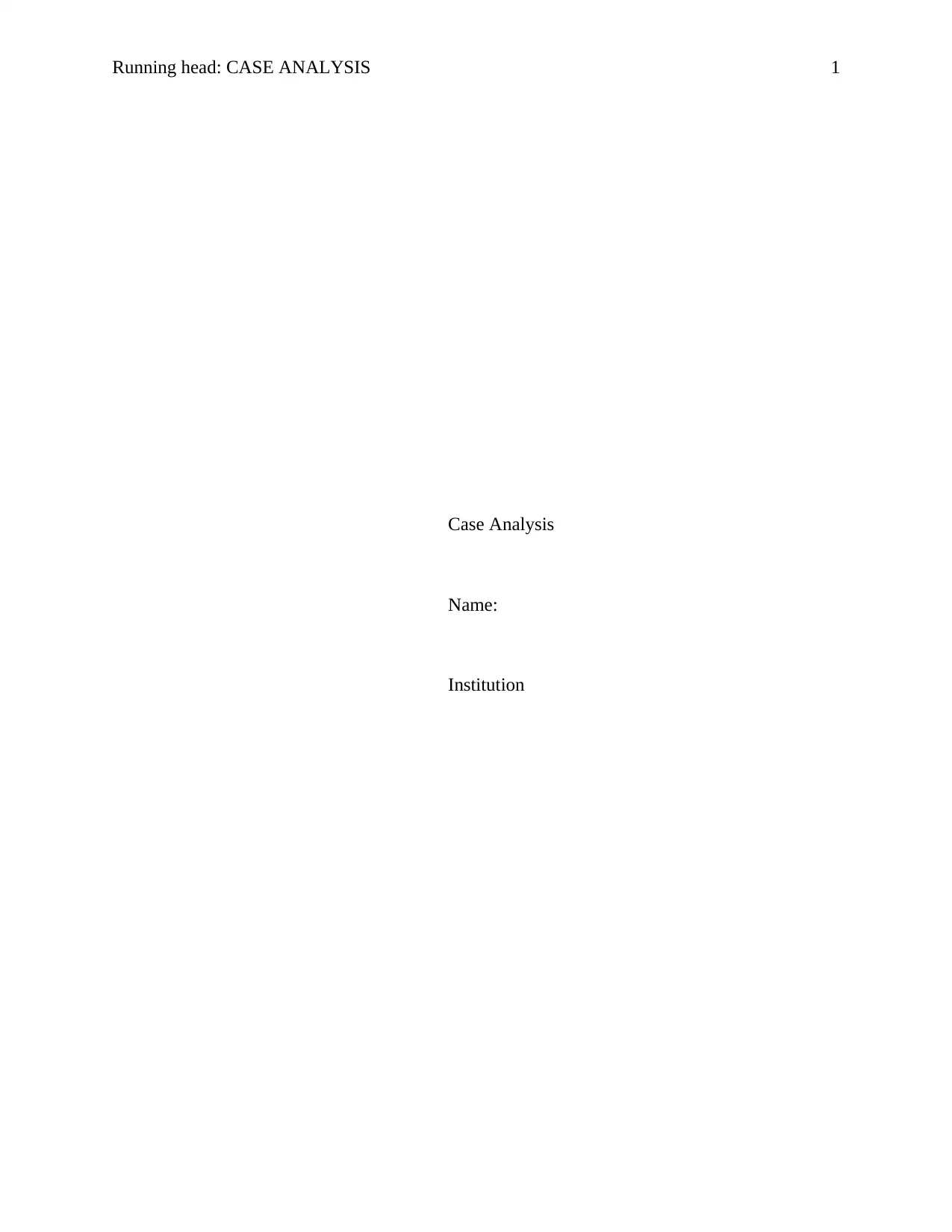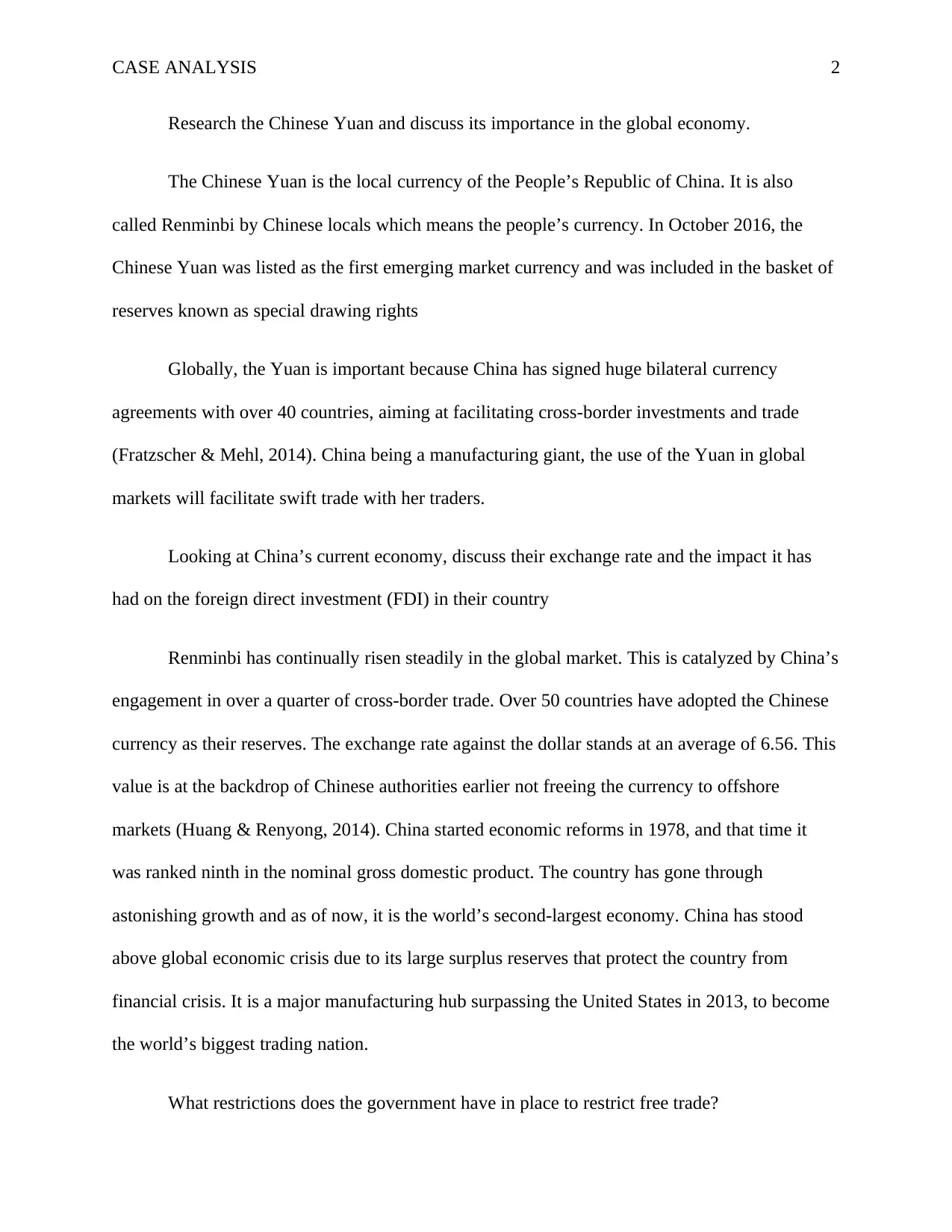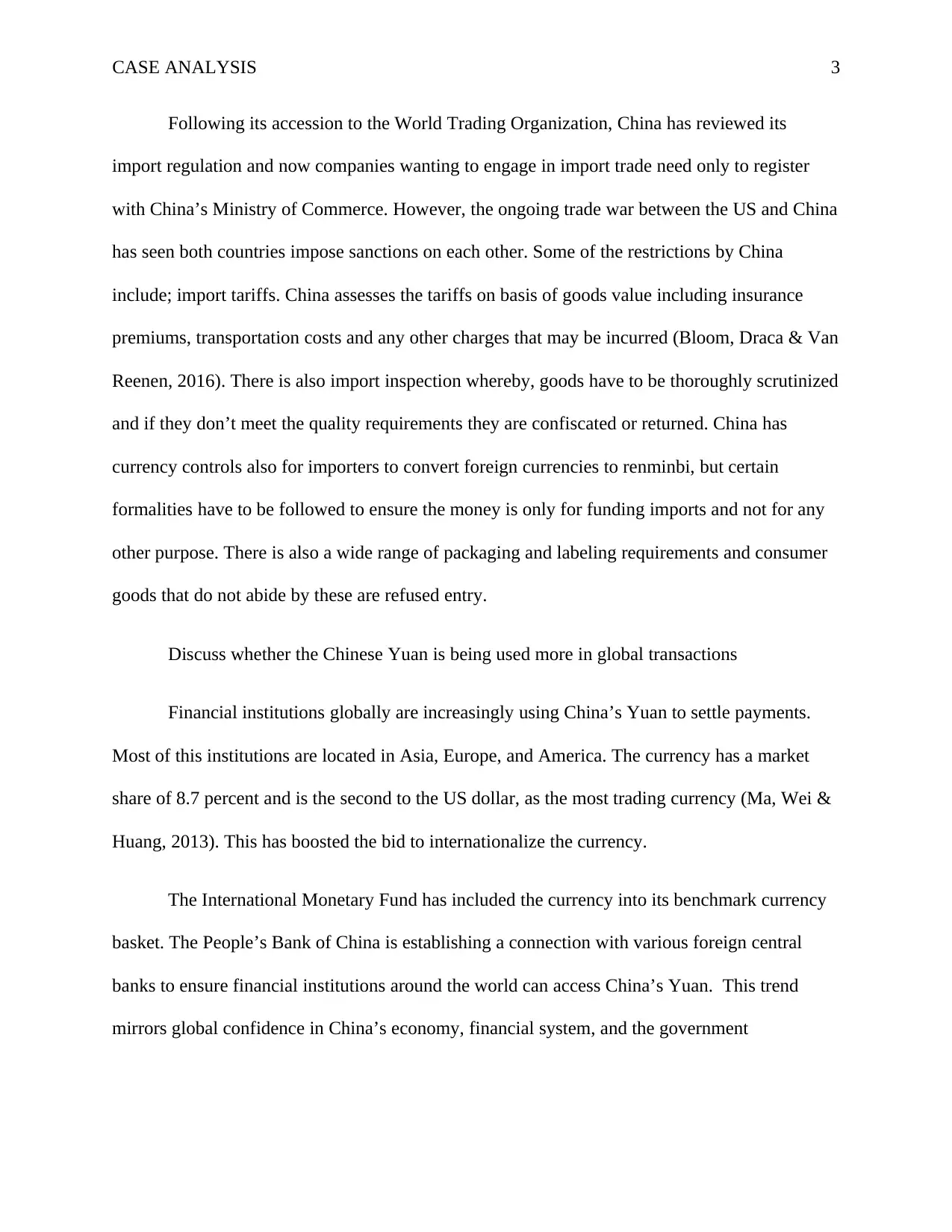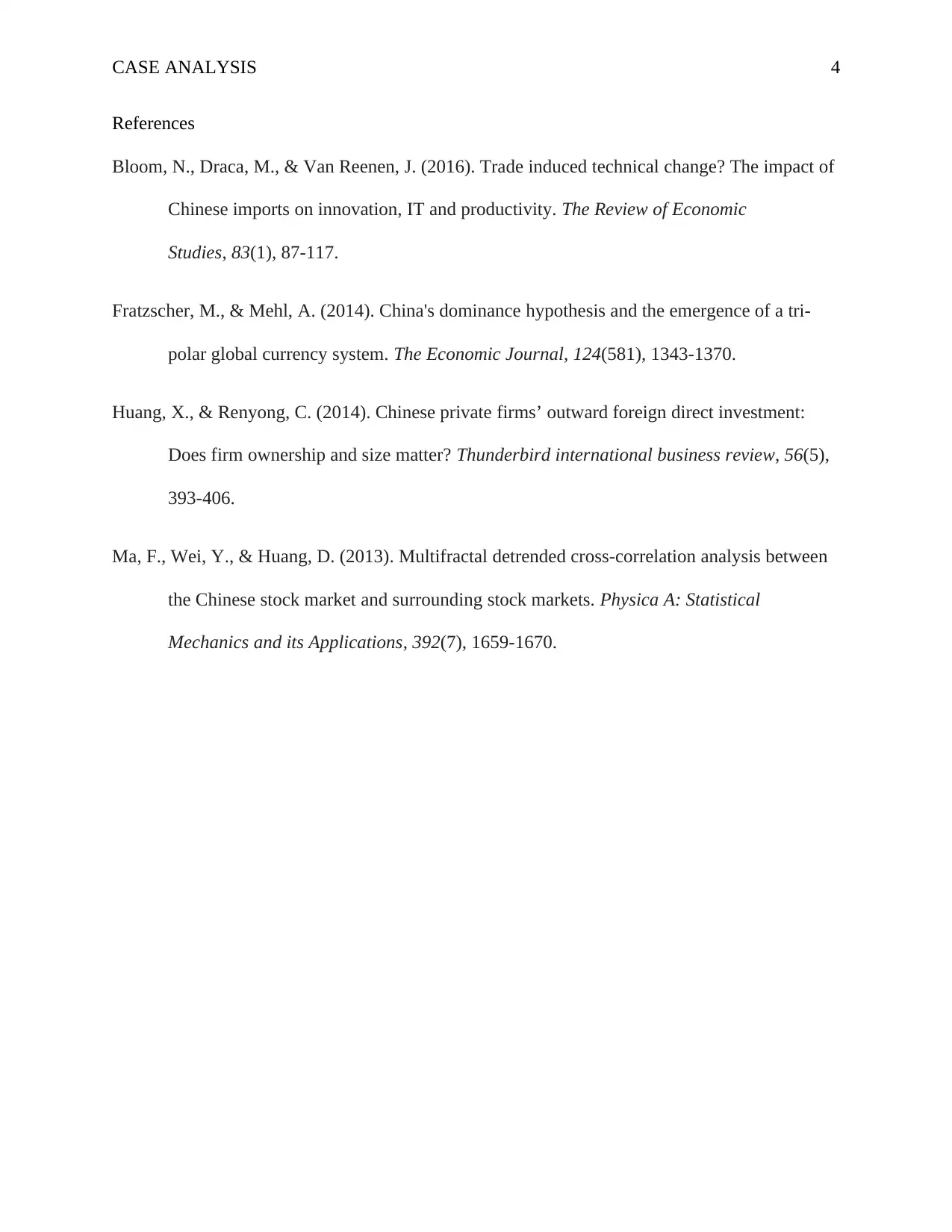Case Analysis: Chinese Yuan in the Global Economy - Analysis
VerifiedAdded on 2023/06/03
|4
|863
|68
Case Study
AI Summary
This case analysis examines the Chinese Yuan (Renminbi) and its significance in the global economy, highlighting its inclusion in the SDR basket and its role in facilitating international trade. It discusses China's exchange rate, its impact on foreign direct investment (FDI), and the restrictions the government imposes on free trade, such as import tariffs, inspections, currency controls, and labeling requirements. The analysis further explores the increasing use of the Chinese Yuan in global transactions, particularly among financial institutions in Asia, Europe, and America, and its growing market share. The paper is formatted in current APA style and supported by references from outside of the textbook.

Running head: CASE ANALYSIS 1
Case Analysis
Name:
Institution
Case Analysis
Name:
Institution
Paraphrase This Document
Need a fresh take? Get an instant paraphrase of this document with our AI Paraphraser

CASE ANALYSIS 2
Research the Chinese Yuan and discuss its importance in the global economy.
The Chinese Yuan is the local currency of the People’s Republic of China. It is also
called Renminbi by Chinese locals which means the people’s currency. In October 2016, the
Chinese Yuan was listed as the first emerging market currency and was included in the basket of
reserves known as special drawing rights
Globally, the Yuan is important because China has signed huge bilateral currency
agreements with over 40 countries, aiming at facilitating cross-border investments and trade
(Fratzscher & Mehl, 2014). China being a manufacturing giant, the use of the Yuan in global
markets will facilitate swift trade with her traders.
Looking at China’s current economy, discuss their exchange rate and the impact it has
had on the foreign direct investment (FDI) in their country
Renminbi has continually risen steadily in the global market. This is catalyzed by China’s
engagement in over a quarter of cross-border trade. Over 50 countries have adopted the Chinese
currency as their reserves. The exchange rate against the dollar stands at an average of 6.56. This
value is at the backdrop of Chinese authorities earlier not freeing the currency to offshore
markets (Huang & Renyong, 2014). China started economic reforms in 1978, and that time it
was ranked ninth in the nominal gross domestic product. The country has gone through
astonishing growth and as of now, it is the world’s second-largest economy. China has stood
above global economic crisis due to its large surplus reserves that protect the country from
financial crisis. It is a major manufacturing hub surpassing the United States in 2013, to become
the world’s biggest trading nation.
What restrictions does the government have in place to restrict free trade?
Research the Chinese Yuan and discuss its importance in the global economy.
The Chinese Yuan is the local currency of the People’s Republic of China. It is also
called Renminbi by Chinese locals which means the people’s currency. In October 2016, the
Chinese Yuan was listed as the first emerging market currency and was included in the basket of
reserves known as special drawing rights
Globally, the Yuan is important because China has signed huge bilateral currency
agreements with over 40 countries, aiming at facilitating cross-border investments and trade
(Fratzscher & Mehl, 2014). China being a manufacturing giant, the use of the Yuan in global
markets will facilitate swift trade with her traders.
Looking at China’s current economy, discuss their exchange rate and the impact it has
had on the foreign direct investment (FDI) in their country
Renminbi has continually risen steadily in the global market. This is catalyzed by China’s
engagement in over a quarter of cross-border trade. Over 50 countries have adopted the Chinese
currency as their reserves. The exchange rate against the dollar stands at an average of 6.56. This
value is at the backdrop of Chinese authorities earlier not freeing the currency to offshore
markets (Huang & Renyong, 2014). China started economic reforms in 1978, and that time it
was ranked ninth in the nominal gross domestic product. The country has gone through
astonishing growth and as of now, it is the world’s second-largest economy. China has stood
above global economic crisis due to its large surplus reserves that protect the country from
financial crisis. It is a major manufacturing hub surpassing the United States in 2013, to become
the world’s biggest trading nation.
What restrictions does the government have in place to restrict free trade?

CASE ANALYSIS 3
Following its accession to the World Trading Organization, China has reviewed its
import regulation and now companies wanting to engage in import trade need only to register
with China’s Ministry of Commerce. However, the ongoing trade war between the US and China
has seen both countries impose sanctions on each other. Some of the restrictions by China
include; import tariffs. China assesses the tariffs on basis of goods value including insurance
premiums, transportation costs and any other charges that may be incurred (Bloom, Draca & Van
Reenen, 2016). There is also import inspection whereby, goods have to be thoroughly scrutinized
and if they don’t meet the quality requirements they are confiscated or returned. China has
currency controls also for importers to convert foreign currencies to renminbi, but certain
formalities have to be followed to ensure the money is only for funding imports and not for any
other purpose. There is also a wide range of packaging and labeling requirements and consumer
goods that do not abide by these are refused entry.
Discuss whether the Chinese Yuan is being used more in global transactions
Financial institutions globally are increasingly using China’s Yuan to settle payments.
Most of this institutions are located in Asia, Europe, and America. The currency has a market
share of 8.7 percent and is the second to the US dollar, as the most trading currency (Ma, Wei &
Huang, 2013). This has boosted the bid to internationalize the currency.
The International Monetary Fund has included the currency into its benchmark currency
basket. The People’s Bank of China is establishing a connection with various foreign central
banks to ensure financial institutions around the world can access China’s Yuan. This trend
mirrors global confidence in China’s economy, financial system, and the government
Following its accession to the World Trading Organization, China has reviewed its
import regulation and now companies wanting to engage in import trade need only to register
with China’s Ministry of Commerce. However, the ongoing trade war between the US and China
has seen both countries impose sanctions on each other. Some of the restrictions by China
include; import tariffs. China assesses the tariffs on basis of goods value including insurance
premiums, transportation costs and any other charges that may be incurred (Bloom, Draca & Van
Reenen, 2016). There is also import inspection whereby, goods have to be thoroughly scrutinized
and if they don’t meet the quality requirements they are confiscated or returned. China has
currency controls also for importers to convert foreign currencies to renminbi, but certain
formalities have to be followed to ensure the money is only for funding imports and not for any
other purpose. There is also a wide range of packaging and labeling requirements and consumer
goods that do not abide by these are refused entry.
Discuss whether the Chinese Yuan is being used more in global transactions
Financial institutions globally are increasingly using China’s Yuan to settle payments.
Most of this institutions are located in Asia, Europe, and America. The currency has a market
share of 8.7 percent and is the second to the US dollar, as the most trading currency (Ma, Wei &
Huang, 2013). This has boosted the bid to internationalize the currency.
The International Monetary Fund has included the currency into its benchmark currency
basket. The People’s Bank of China is establishing a connection with various foreign central
banks to ensure financial institutions around the world can access China’s Yuan. This trend
mirrors global confidence in China’s economy, financial system, and the government
⊘ This is a preview!⊘
Do you want full access?
Subscribe today to unlock all pages.

Trusted by 1+ million students worldwide

CASE ANALYSIS 4
References
Bloom, N., Draca, M., & Van Reenen, J. (2016). Trade induced technical change? The impact of
Chinese imports on innovation, IT and productivity. The Review of Economic
Studies, 83(1), 87-117.
Fratzscher, M., & Mehl, A. (2014). China's dominance hypothesis and the emergence of a tri‐
polar global currency system. The Economic Journal, 124(581), 1343-1370.
Huang, X., & Renyong, C. (2014). Chinese private firms’ outward foreign direct investment:
Does firm ownership and size matter? Thunderbird international business review, 56(5),
393-406.
Ma, F., Wei, Y., & Huang, D. (2013). Multifractal detrended cross-correlation analysis between
the Chinese stock market and surrounding stock markets. Physica A: Statistical
Mechanics and its Applications, 392(7), 1659-1670.
References
Bloom, N., Draca, M., & Van Reenen, J. (2016). Trade induced technical change? The impact of
Chinese imports on innovation, IT and productivity. The Review of Economic
Studies, 83(1), 87-117.
Fratzscher, M., & Mehl, A. (2014). China's dominance hypothesis and the emergence of a tri‐
polar global currency system. The Economic Journal, 124(581), 1343-1370.
Huang, X., & Renyong, C. (2014). Chinese private firms’ outward foreign direct investment:
Does firm ownership and size matter? Thunderbird international business review, 56(5),
393-406.
Ma, F., Wei, Y., & Huang, D. (2013). Multifractal detrended cross-correlation analysis between
the Chinese stock market and surrounding stock markets. Physica A: Statistical
Mechanics and its Applications, 392(7), 1659-1670.
1 out of 4
Related Documents
Your All-in-One AI-Powered Toolkit for Academic Success.
+13062052269
info@desklib.com
Available 24*7 on WhatsApp / Email
![[object Object]](/_next/static/media/star-bottom.7253800d.svg)
Unlock your academic potential
Copyright © 2020–2025 A2Z Services. All Rights Reserved. Developed and managed by ZUCOL.





